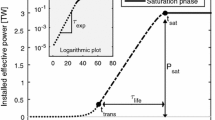Abstract
The population of the world is increasing, mainly in the developing world, and is projected to saturate within about 100 years at up to twice the present population of 6 billion people [1]. Studies [2,3,4] show that, historically, the population growth rate has varied inversely as the annual per capita energy use in most parts of the developing world, where per capita energy use is typically less than 1 tonne of oil equivalent energy per year. However, in areas with more than 2 to 3 tonnes of oil equivalent of energy per year per person the growth rate is around zero. If this trend continues, a stable world population will require, allowing for energy efficiency improvements, some 2 to 3 times the present annual energy use. There is an abundance of energy in the world both exploited and potential to meet this need—fossil, fission, and renewables—but it is not evenly distributed, some is costly, and there are issues of environmental pollution in present use, that may limit use. Fusion energy is a potential longer-term source with attractive environmental features. It is the least developed energy option and still faces a challenging development path, but there are many of areas of the world that would benefit hugely from its deployment from the latter part of the 21st century onward, and it is important to consider how it might be deployed. Most fusion power plant options considered today show an economy of scale, owing to the fixed distance needed for shielding fusion neutrons, tritium breeding and handling the heat loads. One interesting approach is to use the power plant to co-produce electricity and hydrogen to facilitate the introduction of lower cost-of-electricity, multi-gigawatt power plants [5].
Similar content being viewed by others
REFERENCES
E. Bos, My T. Vu, E. Massiah, and R. A. Bulatao, World Population Projections: 1994–95 Edition, published for the World Bank.
J. Goldemberg and T. B. Johansson, eds. (1995). Energy As An Instrument for Socio-Economic Development, United Nations Development Programme, New York, 9.
United Nations Statistical Yearbooks, 10th issue, 1965; 20th issue, 1975; 22nd issue, 1977; 32rd issue, 1987; and 39th issue 1994, United Nations publications.
J. Sheffield (1998). Population Growth and the Role of Energy Use Per Capita, Journal of Technological Forecasting and Social Change 59, 55-87.
J. Sheffield, W. Brown, G. Garrett, J. Hilley, D. McCloud, J. Ogden, T. Shields, and L. Waganer, A Study of Options for the Deployment of Large Fusion Power Plants, Joint Institute for Energy and Environment at the University of Tennessee Report 2000-06, accepted for publication in Fusion Technology, 2000.
J. E. Cohen, How Many People Can the Earth Support (1994, Human Sciences Press, Inc) W. W. Norton & Company, New York (1995).
T. M. L. Wigley, R. Richels, and J. A. Edmond (1996). Economic and environmental choices in the stabilization of atmospheric CO2 concentrations, Nature 379, 240.
H. Herzog, E. Drake, and E. Adams, CO2 Capture, Reuse, and Storage Technologies for Mitigating Global Climate Change, a final report for DOE Order No. DE-AF22-96PC01257, Energy laboratory, Massachusetts Institute of Technology, 77 Massachusetts Avenue, Cambridge, MA, January (1997).
T. B. Johansson, H. Kelley, A. K. N. Reddy, and R. H. Williams (1993). Renewable Fuels and Electricity for a Growing World Economy: Defining and Achieving the Potential, in T. B. Johansson et al. (eds), Renewable Energy: Sources for Fuels and Electricity Washington: Island Press 1-71.
R. Socolow, editor, Fuels Decarbonization and Carbon Sequestration; Report of a Workshop, by the members of the report committee. Center for Energy and Environmental Studies, Princeton University, Princeton NJ, report PU/CEES No 302 (1997).
International Energy Agency, World Energy Outlook, IEA, Paris: OECD (1995).
J. Sheffield (1999). World population and energy demand growth: the potential role of fusion energy in an efficient world, Phil. Trans. R. Soc. Lond. A 357, 377-395.
ITER, Technical Basis for the Final Design Report, Cost Review, and Safety Analysis (FDR), International Energy Agency, Vienna (1998).
National Ignition Facility, Conceptual Design Report, Lawrence Livermore National Laboratory, Livermore, CA, UCRL-PROP-117093 (1994).
R. L. Miller and the ARIES Team, Fusion power plant economics, Proceedings of the Twelfth Topical Meeting on the Technology of Fusion Energy, ANS, December (1996).
J. G. Delene, J. Sheffield, K. A. Williams, R. L. Reid, and S. Hadley, An Assessment of the Economics of Future Electric Power Generation Options and the Implications for Fusion, Oak Ridge National Laboratory Report ORNL/TM-1999/243/R1, 1999.
L. M. Waganer and the ARIES Team, Assessments of Markets and Customers for Fusion Applications, 17th IEEE/NPSS Symposium on Fusion Engineering, San Diego, California, 6–9 October (1997) and updates.
Author information
Authors and Affiliations
Rights and permissions
About this article
Cite this article
Sheffield, J. Forecasts for the 21st Century. Journal of Fusion Energy 18, 23–26 (1999). https://doi.org/10.1023/A:1018818807067
Issue Date:
DOI: https://doi.org/10.1023/A:1018818807067




